LILACS
(Last updated 12/10/03)
There are about 24 native species of
lilacs (genus Syringa), including both shrub and tree forms. The
Persians apparently grew a species native to western China as
early as the 13th c, but the fragrant purple lilac, S. vulgaris,
a species native to southeastern Europe, is the source of our
most familiar garden plants. It was apparently grown fairly widely
even in central Europe before the 16th c, but the ambassador Count de Busbecq
is credited with introducing it (as well as the Angora goat, horse
chestnut, mock orange, and tulip)
to Vienna - and Europe - from Constantinople in 1563.
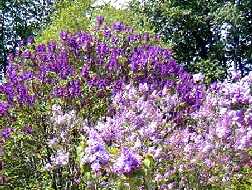
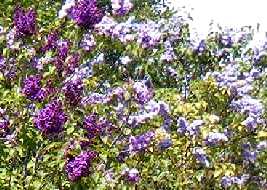 The best known lilac cultivars, the
so-called "French hybrids" were developed primarily
by Lemoine et Fils of Nancy, who initiated a lilac breeding revolution
with the species in the 1870s; the family's efforts lasted into
the 1950s through three generations, and produced more than 200
named cultivars.
The best known lilac cultivars, the
so-called "French hybrids" were developed primarily
by Lemoine et Fils of Nancy, who initiated a lilac breeding revolution
with the species in the 1870s; the family's efforts lasted into
the 1950s through three generations, and produced more than 200
named cultivars.
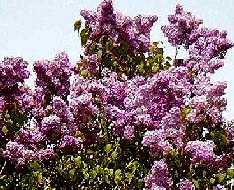
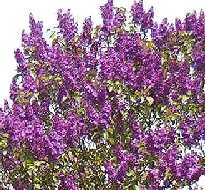 European settlers brought lilacs to
the United States in the 1620s, and by the 1650s they were grown
throughout the colonies. Because they need a period of cold dormancy
to trigger flowering, lilacs are closely associated with the Northeast
and Canada; eg, the Highland Park Lilac Festival in Rochester,
NY attracts over half a million people annually to view more than
1200 bushes representing over 500 varieties, the Royal Botanical
Gardens in Hamilton, Ontario, which also contains a huge lilac
collection, is home to the International Registration Authority
for new cultivars, and there are plants at the Wentworth estate
in Portsmouth, NH, and on Mackinac Island in MI that are purported
to be over 250 years old.
European settlers brought lilacs to
the United States in the 1620s, and by the 1650s they were grown
throughout the colonies. Because they need a period of cold dormancy
to trigger flowering, lilacs are closely associated with the Northeast
and Canada; eg, the Highland Park Lilac Festival in Rochester,
NY attracts over half a million people annually to view more than
1200 bushes representing over 500 varieties, the Royal Botanical
Gardens in Hamilton, Ontario, which also contains a huge lilac
collection, is home to the International Registration Authority
for new cultivars, and there are plants at the Wentworth estate
in Portsmouth, NH, and on Mackinac Island in MI that are purported
to be over 250 years old.
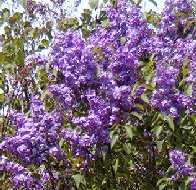
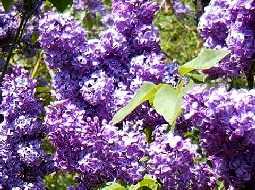 However, some lilacs also grow well
in the Northwest, in particular the over 70 varieties developed
in the early 1900s by Hulda Klager, "The Lilac Lady",
in Woodland, WA, ca 35 mi north of Portland. Her 2-story farmhouse
(right) and the surrounding five acres of gardens are open to
the public during early May
However, some lilacs also grow well
in the Northwest, in particular the over 70 varieties developed
in the early 1900s by Hulda Klager, "The Lilac Lady",
in Woodland, WA, ca 35 mi north of Portland. Her 2-story farmhouse
(right) and the surrounding five acres of gardens are open to
the public during early May
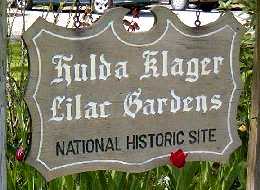
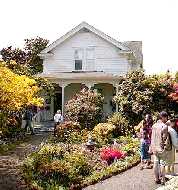 In addition to the many acres of lilacs,
the gardens also contain some spectacular specimen plantings,
including a wonderful wisteria arbor (left) and a monkey puzzle
tree (right)
In addition to the many acres of lilacs,
the gardens also contain some spectacular specimen plantings,
including a wonderful wisteria arbor (left) and a monkey puzzle
tree (right)
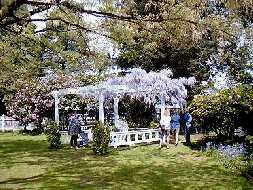
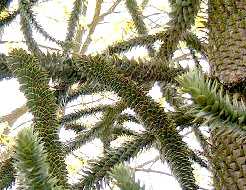 Except for S. vulgaris (and S. josikaea,
the Hungarian lilac), species lilacs come from Asia; and some
of these made their way into European and American gardens as
early as the late 19th c. Today, among the most commonly cultivated
and hybridized are S. chinensis, the Chinese (or "Persian")
lilac, a shrub growing 10 to 12 ft tall and 6 to 8 ft wide (its
hybrids were initially developed in Rouen, France); S. meyeri,
the dwarf Korean (or paliban) lilac, a spreading shrub that grows
only 4 to 5 ft high; S. patula, the Manchurian lilac (eg, "Miss
Kim"), a densely branched, rounded shrub 5 to 6 feet wide
and tall; and S. reticulata, the Japanese tree lilac, which grows
over 25 ft tall, 15 feet wide, and blooms very late, bearing white
flowers in June
Except for S. vulgaris (and S. josikaea,
the Hungarian lilac), species lilacs come from Asia; and some
of these made their way into European and American gardens as
early as the late 19th c. Today, among the most commonly cultivated
and hybridized are S. chinensis, the Chinese (or "Persian")
lilac, a shrub growing 10 to 12 ft tall and 6 to 8 ft wide (its
hybrids were initially developed in Rouen, France); S. meyeri,
the dwarf Korean (or paliban) lilac, a spreading shrub that grows
only 4 to 5 ft high; S. patula, the Manchurian lilac (eg, "Miss
Kim"), a densely branched, rounded shrub 5 to 6 feet wide
and tall; and S. reticulata, the Japanese tree lilac, which grows
over 25 ft tall, 15 feet wide, and blooms very late, bearing white
flowers in June
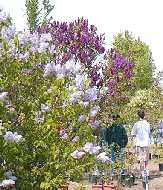
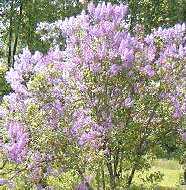
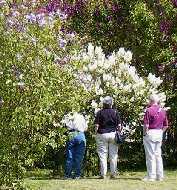 Other species used in hybridization
are the early-flowering S. oblata (eg, the hyacinthiflora hybrids);
the late-flowering S. villosa (eg, the Preston hybrids) and S.
josikaea (the josiflexa tribrids); and the heat and mildew resistant
S. microphylla, or little-leaf lilac.
Other species used in hybridization
are the early-flowering S. oblata (eg, the hyacinthiflora hybrids);
the late-flowering S. villosa (eg, the Preston hybrids) and S.
josikaea (the josiflexa tribrids); and the heat and mildew resistant
S. microphylla, or little-leaf lilac.
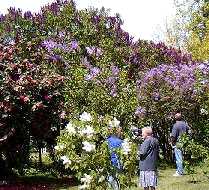
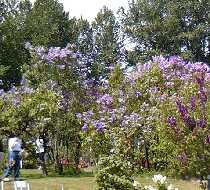 Today almost 2,000 lilac varieties
are available. Single lilac flowers consist of 4 petals (left),
while doubles have multiple sets of four; both span a variety
of colors - white, creamy yellow, pink, blue, violet, lavender,
magenta, and purple. Van Eaton (center) is a blue with pink buds.
There are also bicolor cultivars like "Sensation," which
has sharply defined white picotee edges (right)
Today almost 2,000 lilac varieties
are available. Single lilac flowers consist of 4 petals (left),
while doubles have multiple sets of four; both span a variety
of colors - white, creamy yellow, pink, blue, violet, lavender,
magenta, and purple. Van Eaton (center) is a blue with pink buds.
There are also bicolor cultivars like "Sensation," which
has sharply defined white picotee edges (right)
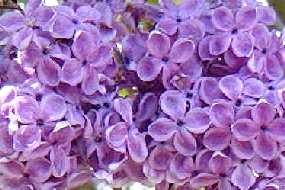
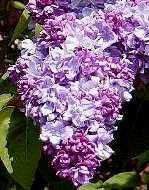
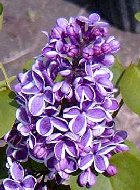 Return to Home Page
Return to Home Page



















